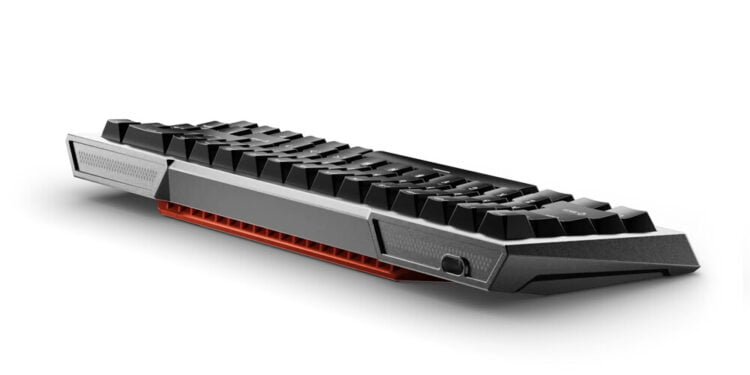[ad_1]
Valve has announced a new Steam Deck . It might not look like a big change from the outside, but the Steam Deck OLED is a thorough mid-cycle refresh of a machine that’s not even two years old. At the same time, Valve is also adjusting the configuration of its entry-level model, making it a far more compelling option.
At an event held for press prior to the device’s launch, Greg Coomer, a product designer at Valve, called the new model “the definitive version of the Steam Deck.” He explained that the device contains many things the company wanted to include at the LCD model’s launch but wasn’t able to, along with some additions based on community feedback.

As its name suggests, the most noticeable upgrade to the Steam Deck OLED is the display. The original Steam Deck had a 7-inch 800p LCD running at 60Hz. The new model squeezes a 7.4-inch OLED screen into the same space, significantly shrinking the bezels around the display. The new panel runs at the same resolution, but with a refresh rate of up to 90Hz. It’s also HDR, covering 110 percent of the P3 color space with a peak brightness of 1,000 nits — the old model maxed out at around 400 nits. Like all OLED screens, it has pure blacks and near-instantaneous response times. As before, anti-glare etched glass is available, but only on the premium model.
The Steam Deck OLED has a die-shrunk version of the same custom APU found in the original Steam Deck. The new APU is produced on a 6nm process, rather than the older 7nm process. Manufacturers typically use die-shrinks to either improve performance or efficiency, and Valve has chosen the latter. The max frequency of both the GPU and CPU are identical between the LCD and OLED models, so for developers tuning their games for Steam Decks, they only have a single performance target.
In concert with the more-efficient processor, there’s also a 25 percent larger battery with a 50Whr capacity, compared to the original’s 40Whr. According to Valve, these changes combined result in a 30-50 percent increase in longevity between the two generations — the official battery life claim is “three to 12 hours.” In our review, we measured a playtime increase of 62 percent when playing Hades on the OLED model versus our 18-month-old original. (Batteries degrade over time, which explains why our gains were more pronounced.)
The new internals make the Steam Deck OLED marginally lighter, and also cooler to the touch when playing games, aided by a slightly larger fan. Other improvements include support for both Wi-Fi 6E and Bluetooth 5.3, together with a new antenna array that will give a better experience when using both at the same time. There’s also a reworked power supply (it has a logo now!) with a longer 2.5m cable that will charge the OLED model from 20 to 80 percent in “as little as 45 minutes.” The thumbsticks have also been made 1mm taller, and the touch pads’ haptics are slightly sharper.
The Steam Deck OLED starts at $549, and will replace all but the entry-level model in the range. The immediate reality is a bit of a mess and a little complicated, but this, Valve says, will be the Steam Deck line-up moving forward:
256GB Steam Deck LCD ($399)
512GB Steam Deck OLED ($549)
1TB Steam Deck OLED ($649)
As a result of the changes, the 64GB LCD Steam Deck (previously sold at $399) will drop to $349, and the 512GB LCD (previously $649) will drop to $499. Once Valve sells through its inventory of both, those lines will be discontinued. Valve says it will continue to support all LCD models with software updates.
So, the long-term lineup starts at the same $399 price, which gets you the old LCD Steam Deck, but with 256GB of storage instead of 64GB. The new step-up model costs $20 more at $549, but comes with an OLED display and the improvements outlined above, plus double the storage. The range still tops out at $649, but you’re getting a lot more for your money: All of the hardware improvements, 1TB of storage instead of 512GB and an improved carry case that can pop out into a slimmer shell that’s smaller and easier to fit in a bag. As mentioned, it also has the same anti-glare etched glass as the outgoing 512GB LCD model.
Finally, there’s also a Limited Edition version of the 1TB model, with a translucent shell and a customized carry case, which will be sold at $679. We imagine stocks will not last very long, as it looks pretty rad:
While there are no concrete updates on future hardware developments, Valve engineer Pierre-Loup Griffais noted that, so long as interest in handheld gaming remains high, the company has “plans for successive generations of handhelds.” For now, Griffais explained, it’s important to Valve that developers don’t need to “split their attention” between different performance targets.
When asked about the potential for future hardware — like a return of the Steam Machine or an updated Steam Controller — there were no firm updates, but there does seem to be something happening. Griffais agreed that enabling the Steam Deck to work as a hybrid living room console was a “side goal” of the team, and noted that everything Valve does to improve SteamOS will benefit other devices. ..
The Steam Deck OLED will be available to order on November 16th at 1PM ET. Valve expects units to begin shipping as soon as orders start to roll in. The updated pricing on the existing LCD models is already in effect.
[ad_2]
Source link










